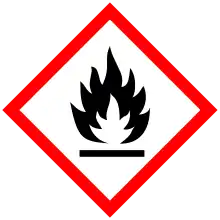Rhodinol
With respect to chemical compounds, Rhodinol refers to 3,7-dimethyloct-7-en-1-ol. As the (3S) isomer it is CAS 6812-78-8, and as the racemate it is CAS 141-25-3.
 | |
| Names | |
|---|---|
| IUPAC name
(3S)-3,7-Dimethyloct-7-en-1-ol | |
| Other names
α-Citronellol, 3,7-Dimethyl-(6- or 7-)octen-1-ol, 3,7-Dimethyl-7-octen-1-ol, 1-Citronellol | |
| Identifiers | |
3D model (JSmol) |
|
| ChEMBL | |
| ChemSpider | |
| ECHA InfoCard | 100.004.977 |
| EC Number |
|
PubChem CID |
|
| UNII | |
CompTox Dashboard (EPA) |
|
| |
| Properties | |
| C10H20O | |
| Molar mass | 156.269 g·mol−1 |
| Hazards | |
| GHS pictograms |    |
| GHS Signal word | Danger |
| H315, H317, H318, H319, H411 | |
| P261, P264, P272, P273, P280, P302+352, P305+351+338, P310, P321, P332+313, P333+313, P337+313, P362, P363, P391, P501 | |
Except where otherwise noted, data are given for materials in their standard state (at 25 °C [77 °F], 100 kPa). | |
| Infobox references | |
In the field of perfumery materials, the term may refer to L-citronellol, to mixtures mostly comprising L- or racemic citronellol and geraniol, or to mixtures mostly comprising racemic 3,7-dimethyloct-7-en-1-ol and racemic citronellol.
Two example synthetic Rhodinol products are Rhodinol 70, a racemic mixture comprising 40-60% 3,7-dimethyloct-7-en-1-ol and 40-60% citronellol, and Sigma-Aldrich Rhodinol, which consists of L-citronellol and geraniol.
Rhodinol is also provided in perfumery in natural grades as materials extracted from geranium or citronella, comprising principally citronellol and geraniol.
Rhodinol products are used in cosmetics and perfumery to impart flowery odors, particularly but not limited to being a component of rosy odor.[1]
3,7-Dimethyloct-7-en-1-ol does not appear substantively in nature. [2]
References
- RhodinolThe Good Scents Company
- The Citronellol Problem and the Isolation of α-CitronellolJournal of the American Chemical Society
